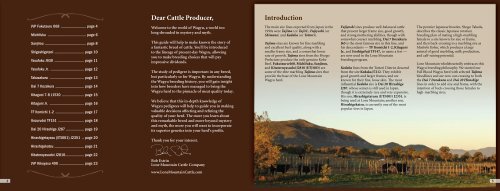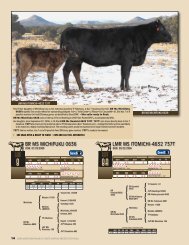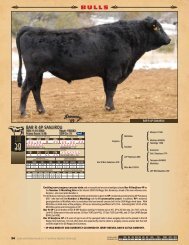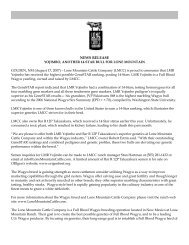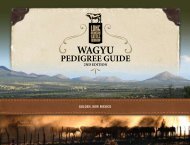PEDIGREE GUIDE - The Lone Mountain Cattle Company
PEDIGREE GUIDE - The Lone Mountain Cattle Company
PEDIGREE GUIDE - The Lone Mountain Cattle Company
You also want an ePaper? Increase the reach of your titles
YUMPU automatically turns print PDFs into web optimized ePapers that Google loves.
Dear <strong>Cattle</strong> Producer,<br />
Introduction<br />
JVP Fukutsuru 068 .......................... page 4<br />
Michifuku ........................................ page 6<br />
Sanjirou .......................................... page 8<br />
Shigeshigetani .............................. page 10<br />
Yasufuku J930 ............................... page 11<br />
Yasufuku Jr. ................................... page 12<br />
Takazakura .................................... page 13<br />
Dai 7 Itozakura ............................. page 14<br />
Kitaguni 7-8 J1530 ....................... page 15<br />
Kitaguni Jr. .................................... page 16<br />
TF Itomichi 1-2 .............................. page 17<br />
Itozurudoi TF151 ........................... page 18<br />
Dai 20 Hirashige J287 .................. page 19<br />
Welcome to the world of Wagyu, a world too<br />
long shrouded in mystery and myth.<br />
This guide will help to make known the story of<br />
a fantastic breed of cattle. You’ll be introduced<br />
to the lineage of present-day Wagyu, allowing<br />
you to make breeding choices that will pay<br />
impressive dividends.<br />
<strong>The</strong> study of pedigree is important in any breed,<br />
but particularly so for Wagyu. By understanding<br />
the Wagyu breeding history, you will gain insight<br />
into how breeders have managed to bring the<br />
Wagyu herd to the pinnacle of meat quality today.<br />
We believe that this in-depth knowledge of<br />
Wagyu pedigrees will help to guide you in making<br />
valuable decisions affecting and refining the<br />
quality of your herd. <strong>The</strong> more you learn about<br />
this remarkable breed and move beyond mystery<br />
and myth, the more you will want to incorporate<br />
its superior genetics into your herd’s profile.<br />
<strong>The</strong> main sire lines exported from Japan in the<br />
1990s were Tajima (or Tajiri), Fujiyoshi (or<br />
Shimane) and Kedaka (or Tottori).<br />
Tajima sires are known for fine marbling<br />
and excellent beef quality, along with a<br />
smaller frame size, and a somewhat lower<br />
rate of growth. Tajima sires from the Hyogo<br />
Prefecture produce the only genuine Kobe<br />
Beef. Fukutsuru 068, Michifuku, Sanjirou,<br />
and Kitateruyasudoi J2810 (ETJ 003) are<br />
some of the elite marbling Tajima sires that<br />
provide the base of the <strong>Lone</strong> <strong>Mountain</strong><br />
Wagyu herd.<br />
Fujiyoshi sires produce well-balanced cattle<br />
that present larger frame size, good growth,<br />
and strong mothering abilities, though with<br />
somewhat coarser marbling. Dai 7 Itozakura<br />
J65 is the most famous sire in this line, and<br />
his descendants — TF Itomichi 1-2, Kitaguni<br />
Jr., and Itoshigefuji TF147, to name a few —<br />
are now used in the <strong>Lone</strong> <strong>Mountain</strong><br />
breeding program.<br />
Kedaka lines from the Tottori District descend<br />
from the sire Kedaka J7212. <strong>The</strong>y exhibit<br />
good growth and larger frames, and are<br />
known for their fine, loose skin. <strong>The</strong> most<br />
influential Kedaka sire is Dai 20 Hirashige<br />
J287, whose semen is still used in Japan,<br />
though it is extremely rare and very expensive.<br />
His son, Hirashigetayasu (ETJ 001) J2351, is<br />
being used at <strong>Lone</strong> <strong>Mountain</strong>; another son,<br />
Hirashigekatsu, is currently one of the most<br />
popular sires in Japan.<br />
<strong>The</strong> premier Japanese breeder, Shogo Takeda,<br />
describes the classic Japanese rotation<br />
breeding plan of mating a high-marbling<br />
female to a sire known for size or frame,<br />
and then back-crossing to a marbling sire as<br />
Modoshi Kohai, which produces a large<br />
animal of good marbling, milk production,<br />
and calf-raising potential.<br />
<strong>Lone</strong> <strong>Mountain</strong> wholeheartedly embraces this<br />
Wagyu breeding philosophy. We started our<br />
Full Blood Wagyu herd with selected Tajima<br />
bloodlines and are now out-crossing to both<br />
the Dai 7 Itozakura and Dai 20 Hirashige<br />
lines in order to add size and frame, with the<br />
intention of back-crossing those females to<br />
high-marbling sires.<br />
Hirashigetayasu (ETJ001) J2351 ... page 20<br />
Hirashigekatsu .............................. page 21<br />
Thank you for your interest.<br />
Kitateruyasudoi J2810................... page 22<br />
JVP Kikuyasu 400 ......................... page 23<br />
Bob Estrin<br />
<strong>Lone</strong> <strong>Mountain</strong> <strong>Cattle</strong> <strong>Company</strong><br />
www.<strong>Lone</strong><strong>Mountain</strong><strong>Cattle</strong>.com<br />
2<br />
3


